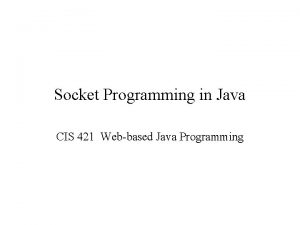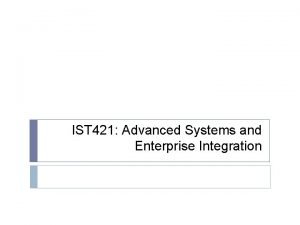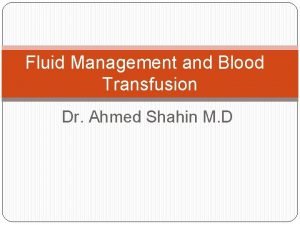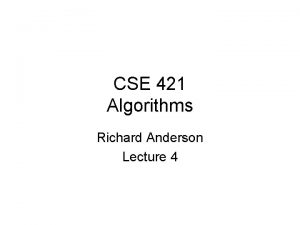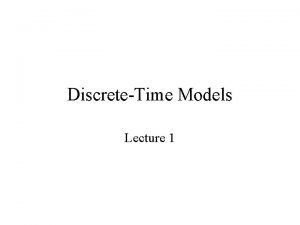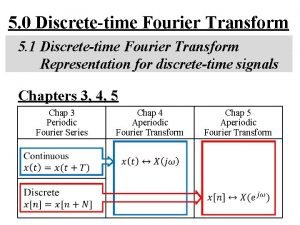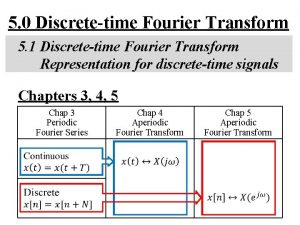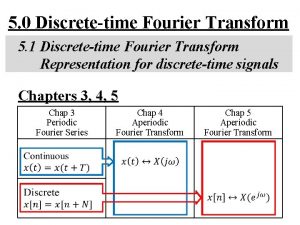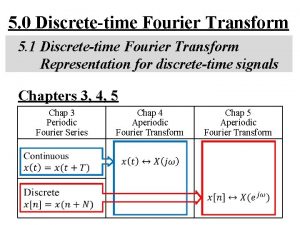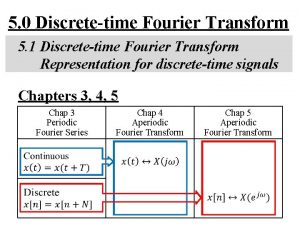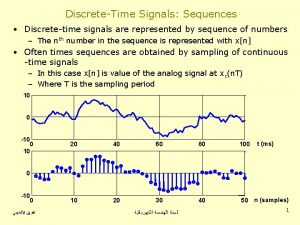Lecture 4 DiscreteTime Systems EE 421 Fall 1998









- Slides: 9

Lecture 4: Discrete-Time Systems EE 421, Fall 1998 Michigan Technological University Timothy J. Schulz l Properties of Systems: – linearity, time-invariance, causality, stability l Properties of LTI Systems: – impulse response • finite impulse response (FIR) n • infinite impulse response (IIR) n – convolution 22 -Sept, 98 EE 421, Lecture 4 1

Processing Methods EE 421, Fall 1998 Michigan Technological University Timothy J. Schulz l Block processing: output values are computed by processing an entire block of input values. – non real-time processing l Sample processing: output values are computed by processing input samples one at a time. – real-time processing 22 -Sept, 98 EE 421, Lecture 4 2

Processing Methods EE 421, Fall 1998 Michigan Technological University Timothy J. Schulz l block processing 22 -Sept, 98 EE 421, Lecture 4 3

Processing Methods EE 421, Fall 1998 Michigan Technological University Timothy J. Schulz l sample processing output state variables x(n) + a 0 r e g 22 -Sept, 98 + a 1 w 1 r e g + a 2 w 2 EE 421, Lecture 4 r e g y(n) a 3 w 3 4

FIR Filters EE 421, Fall 1998 Michigan Technological University Timothy J. Schulz l Impulse response extends only over a finite time: filter coefficients, filter weights, filter taps – filter order = M – convolution equation: causal system 22 -Sept, 98 EE 421, Lecture 4 5

FIR Filters EE 421, Fall 1998 Michigan Technological University Timothy J. Schulz l Examples – y(n) = 2 x(n) + 3 x(n-1) + 5 x(n-2) + 2 x(n-4) impulse response = {. . . , 0, 0, 2, 3, 5, 0, 2, 0, 0, . . . } n=0 – y(n) = (1/4)x(n+1) + (1/2)x(n) + (1/4)x(n-1) impulse response = {. . . , 0, 0, 1/4, 1/2, 1/4, 0, 0, . . . } n=0 22 -Sept, 98 EE 421, Lecture 4 6

IIR Filters EE 421, Fall 1998 Michigan Technological University Timothy J. Schulz l Impulse response extends over an infinite time: – we cannot approach this in the same manner as an FIR filter – IIR filters cannot, in general, be computed! – we restrict our attention to systems described by difference equations: y(n) = y(n-1) + 2 y(n-2) + x(n) - x(n-1) a 0 y(n) + a 1 y(n-1) + … + a. My(n-M) = b 0 x(n) + b 1 x(n-1) + … + b. Lx(n-L) 22 -Sept, 98 EE 421, Lecture 4 7

IIR Filters EE 421, Fall 1998 Michigan Technological University Timothy J. Schulz l Examples: – y(n) = ay(n-1) + x(n) • impulse response: h(n) = ah(n-1) + d(n) • h(n) = anu(n) – y(n) = ay(n-2) + x(n) • impulse response: h(n) = ah(n-2) + d(n) • h(n) = an/2, if n is even; h(n) = 0 otherwise 22 -Sept, 98 EE 421, Lecture 4 8

IIR Filters EE 421, Fall 1998 Michigan Technological University Timothy J. Schulz l Examples: – y(n) = ay(n-1) + x(n-1) – impulse response: h(n) = ah(n-1) + d(n-1) • h(n) = 1 if n=0, h(n) = an-1(1+a)u(n) otherwise 22 -Sept, 98 EE 421, Lecture 4 9

